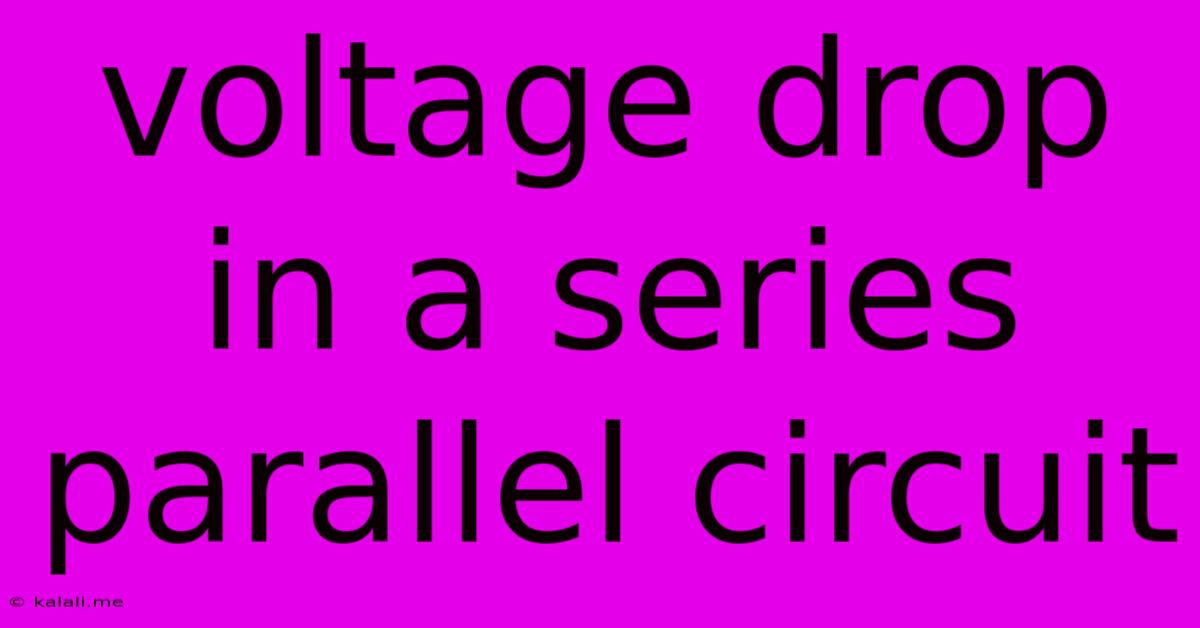Voltage Drop In A Series Parallel Circuit
Kalali
May 25, 2025 · 4 min read

Table of Contents
Understanding Voltage Drop in Series-Parallel Circuits
Understanding voltage drop is crucial for anyone working with electrical circuits, and series-parallel circuits present a unique challenge. This article will break down the concept of voltage drop, specifically within series-parallel circuits, explaining how to calculate it and offering practical examples. This guide will help you master this essential electrical engineering concept.
What is Voltage Drop?
Voltage drop refers to the decrease in electrical potential energy as current flows through a component in a circuit. This drop is caused by the resistance the component offers to the current flow. The greater the resistance, the greater the voltage drop across that component. Think of it like water flowing downhill – the steeper the slope (higher resistance), the greater the drop in water level (voltage).
Series Circuits: A Simple Starting Point
Before tackling series-parallel circuits, let's review series circuits. In a series circuit, components are connected end-to-end, forming a single path for current. The voltage drop across each component is proportional to its resistance. The sum of the individual voltage drops equals the total source voltage (Kirchhoff's Voltage Law).
- Key Characteristic: The current is the same throughout the entire circuit.
Parallel Circuits: A Different Perspective
In a parallel circuit, components are connected across each other, creating multiple paths for current. The voltage across each component is the same, and equal to the source voltage. The total current is the sum of the currents flowing through each branch.
- Key Characteristic: The voltage is the same across all branches.
Series-Parallel Circuits: Combining Concepts
Series-parallel circuits combine elements of both series and parallel configurations. Analyzing these circuits requires a systematic approach to identify series and parallel combinations. This often involves breaking down the circuit into simpler sections.
Calculating Voltage Drop in Series-Parallel Circuits: A Step-by-Step Approach
-
Identify Series and Parallel Sections: Carefully examine the circuit diagram to identify sections connected in series and sections connected in parallel.
-
Simplify Parallel Sections: Calculate the equivalent resistance of each parallel section using the reciprocal formula: 1/Req = 1/R1 + 1/R2 + ...
-
Redraw the Circuit: Replace each simplified parallel section with its equivalent resistance. This will result in a simpler circuit, possibly entirely in series.
-
Calculate Current: Using Ohm's Law (V=IR), calculate the total current flowing through the simplified series circuit.
-
Calculate Voltage Drop (Series Sections): For any remaining series sections, use Ohm's Law to calculate the voltage drop across each component. Remember, the current is the same throughout a series section.
-
Calculate Voltage Drop (Parallel Sections): The voltage drop across each branch of a parallel section is equal to the voltage across the equivalent resistance calculated in step 2. Use Ohm's Law to calculate the current in each branch of the parallel section.
-
Verify Kirchhoff's Voltage Law: The sum of all voltage drops in a closed loop should equal the source voltage. This verification helps identify errors in your calculations.
Example:
Imagine a circuit with a 12V source, a 4Ω resistor in series with a parallel combination of a 6Ω and a 12Ω resistor.
-
Parallel Section: The equivalent resistance of the 6Ω and 12Ω resistors is 4Ω (1/Req = 1/6 + 1/12; Req = 4Ω).
-
Simplified Circuit: The circuit simplifies to a 12V source, a 4Ω resistor, and a 4Ω equivalent resistor in series.
-
Total Current: The total current is 1.5A (I = V/R = 12V / (4Ω + 4Ω)).
-
Voltage Drop (Series): The voltage drop across each 4Ω resistor is 6V (V = IR = 1.5A * 4Ω).
-
Voltage Drop (Parallel): The voltage across both the 6Ω and 12Ω resistors is 6V (same as the voltage drop across the equivalent resistance). Current through the 6Ω is 1A (I = V/R = 6V/6Ω) and current through the 12Ω is 0.5A (I = V/R = 6V/12Ω).
Troubleshooting Tips
- Double-check your calculations: Errors are easy to make, so meticulously review each step.
- Redraw the circuit: Simplify the circuit visually.
- Use Ohm's Law consistently: This is the foundation of circuit analysis.
- Apply Kirchhoff's laws: These laws provide essential checks for accuracy.
By understanding these principles and applying these steps, you can confidently analyze voltage drops in even the most complex series-parallel circuits. Remember, practice is key to mastering this skill.
Latest Posts
Latest Posts
-
Navy Sailor Getting Sucked Into A 6
May 25, 2025
-
20 Amp Outlet On A 15 Amp Circuit
May 25, 2025
-
Applications Of Complex Exponential Signals In Real Life
May 25, 2025
-
How To Clean Rust Stains From Clothes
May 25, 2025
-
Double Sink With Garbage Disposal Plumbing Diagram
May 25, 2025
Related Post
Thank you for visiting our website which covers about Voltage Drop In A Series Parallel Circuit . We hope the information provided has been useful to you. Feel free to contact us if you have any questions or need further assistance. See you next time and don't miss to bookmark.